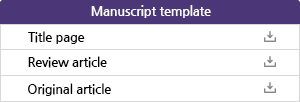Author checklist
- Page Path
-
- HOME
- FOR CONTRIBUTORS
- Author checklist
1. Mandatory components of a manuscript
- The format and content of the manuscript have been checked by the corresponding author.
- The text should be written in 12-point font with double line spacing.
- The original article should be prepared in the following order: title page, abstract, keywords, introduction, materials and methods, results, discussion, conclusion, references, table, and figure legends.
- English-language editing is done before submitting a manuscript.
2. Title page
- The title page should be a separate file, and must contain the names and affiliations of all authors and contact information of the corresponding author.
- The title should be concrete and not exceed 20 words. A running title must be included, consisting of no more than 50 characters/spaces.
3. Abstract
- The abstract should be no longer than 300 words for original articles and review articles.
- The abstract of clinical or laboratory research studies has the following sections: Purpose, Materials and Methods, Results, Conclusion.
- A list of key words, with a minimum of 3 items and maximum of 6 items, is included at the end of the abstract.
- Key words are selected based on Medical Subject Headings (MeSH).
4. Manuscript
- Original Articles should be composed of no more than 3,000 words, excluding references, tables, and figures, and organized in the order of title, abstract, introduction, materials and methods, results, discussion, conclusion, references, tables, and figures or illustrations.
- Review Articles should be composed of no more than 3,500 words, excluding references, tables, and figures.
- The IRB No. is provided if subjects are human.
5. References
- All references should be numbered consecutively in the order in which they are first mentioned in the text. In using in-text reference citation, each reference should be cited in square brackets as [1], [1,2], or [1-3].
- All references cited in the text must be both listed and cited by the reference number (footnotes are not accepted).
- When more than 2 references are cited at a given place in the manuscript, use hyphens to join the first and last numbers of a closed series; use commas without space to separate other parts of a multiple citation.
- If there are more than 6 authors in the end-reference list, name only the first 6 authors and then use et al.
6. Tables, Figures, and Illustrations
- Tables should be created using the table formatting and editing feature of Microsoft Word and should not be provided in noneditable image format.
- Tables and figures are prepared in separate files.
- Each table should be inserted on a separate page, with the table number, table title and legend above the table.
- Figures are submitted individually, not incorporated into one file.
- The preferred file formats for figures are JPG (JPEG) or TIF (TIFF), with a resolution of 300 dpi or more (Line art should have resolution of 1,200 dpi or more).
- Table and figure footnotes should be indicated with superscript symbols in sequence: *, †, ‡, §, ||, ¶, **, ††, ‡‡, etc.


























